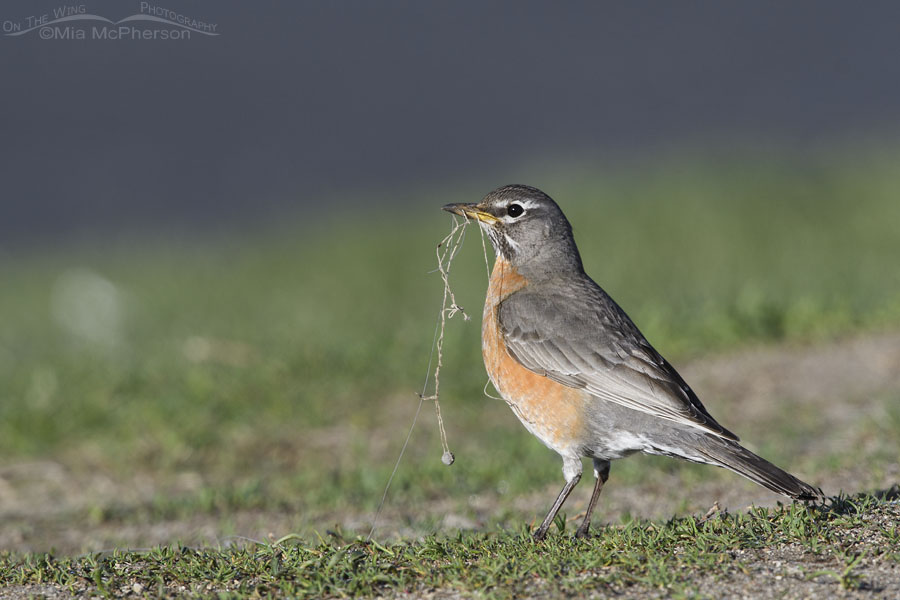All across the country it is nesting season for many North American birds. For some nesting birds it is also a very dangerous time because of fishing line.
 American Robin with dangerous fishing line – Nikon D500, tripod mounted, f7.1, 1/640, ISO 500, +0.7 EV, Nikkor 500mm VR with 1.4x TC, natural light
American Robin with dangerous fishing line – Nikon D500, tripod mounted, f7.1, 1/640, ISO 500, +0.7 EV, Nikkor 500mm VR with 1.4x TC, natural light
Last week while I was photographing Common Loons at a local pond I looked behind myself and spotted this American Robin. I turned my lens around on my tripod to photograph the robin and drew in a deep breath. The robin had a bill filled with discarded fishing line and a fishing weight.
I took a few photos of the robin and then tried to decide what to do. The robin was busy collecting nesting materials and that the fishing line in her bill was dangerous.
Improperly discarded fishing line in a nest can strangle nestlings, cause deformities, and maim and kill them. Fishing line is not a natural nesting material for any birds. Fishing line in nests can kill young eagles, robins, and other songbirds. The adult birds can be killed by fishing line and the nestlings would then starve.
Personally I have seen birds die because of fishing line. I’ve been involved in rescues of birds that are entangled in fishing gear plus I’ve seen birds I wasn’t able to rescue that had hooks in their bills and fishing line wrapped around them because they could still fly.
I never leave my camera gear unattended while I am in the field but in that moment I made the decision to do just that. My thoughts were that if I moved towards the robin she might drop the fishing line. If she dropped the line and weight I could grab it and dispose of it properly.
Unfortunately, the robin flew off with the fishing line in her bill and there was not a single thing I could do about that.
What can be done about fishing line and gear?
Improperly discarded fishing gear, including fishing line, can cause serious harm to birds, marine animals, and the environment. To prevent this from happening, here are some steps that can be taken:
- Dispose of fishing line and gear properly: Always make sure to dispose of fishing line, hooks, and other gear properly. You can recycle used fishing line at designated recycling stations or dispose of it in the trash. Never leave fishing gear on the beach or in the water.
- Carry a trash bag: Bring a small bag with you on your fishing or photography trip to collect any trash, including used fishing gear. This can help prevent litter from accumulating in the environment.
- Use biodegradable fishing line: Consider using biodegradable fishing line, which will break down over time and reduce the risk of harming wildlife.
- Avoid fishing in areas with nesting birds: If you know that a certain area is a nesting ground for birds, avoid fishing in that area. This will reduce the risk of accidentally harming a bird or its habitat.
- Use barbless hooks: Consider using hooks that are specifically designed to be bird-safe. These hooks are less likely to injure or trap birds, reducing the risk of harm.
- Do not use lead weights. A piece of lead smaller than a grain of rice can kill a fully grown Bald Eagle. The impacts on smaller birds are even more severe. Lead, in any amount, is not safe in the environment.
By following these simple steps, you can help protect nesting birds and reduce the environmental impact of fishing gear.
Myself and other bird photographers often pick up fishing line, hooks, lures, weights, and other trash while we are out in the field. It isn’t our garbage but we do it anyway to help birds and wildlife. Please dispose of fishing gear and other refuse properly.
Pack out what you pack in for the safety of birds and wildlife. Do it because it is the right thing to do.
Mia
Read more here: The Dangers of Fishing Line and Hooks for Birds and other Wildlife


Sigh. I frequent despair about our greed and our carelessness, both of which are dangerous.
I hope the robin and her nestlings are ok.
Thanks Mia, I think you should send this to Murry Park officials.
With any luck, she’ll either discard the line/weight or weave it tightly into her nest. Keeping my fingers crossed. Thank you for trying to get it from her.
I’ve never shared one of your posts before, Mia, but I’m super glad that option was available today.
Let’s hope the baby robins survive the fishing line. You did the right thing. Too bad it was unsuccessful.